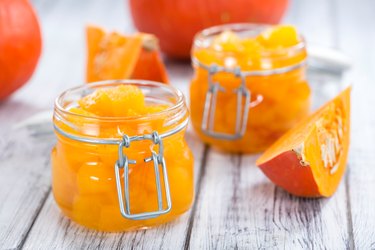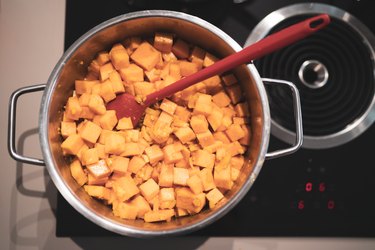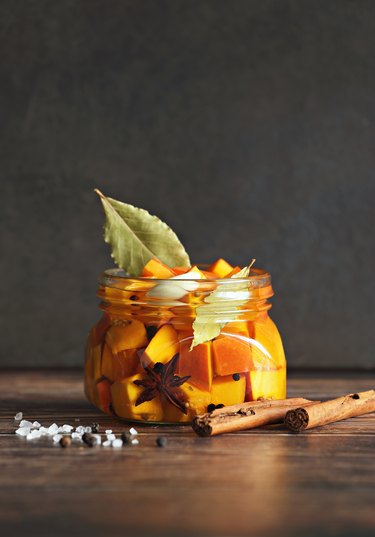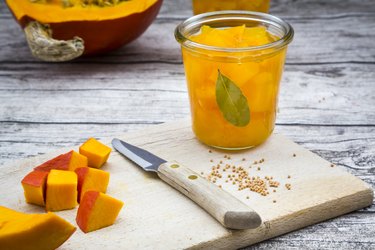Autumn is unequivocally pumpkin season. After all, pumpkins crop up as decorations in stores and on front porches, in baked goods, and—of course—in the form of pumpkin-spice coffee beverages. In the case of dense, sweet "pie" pumpkins and their cousins, the winter squashes, they may even come to your table in the form of a vegetable side dish. One way you might not have thought to use pumpkins is in pickles, but pickled pumpkin is a surprisingly well-established tradition in many places around the world. If you love pumpkin and are trying to find more and better ways to use this seasonal staple, this guide is for you.

Video of the Day
About Pumpkin Pickles
Pumpkins and winter squashes are reasonably durable just as they are, lasting for weeks or even months if they're properly stored. Despite that, pickling them still made a lot of sense for our forebears: Until the invention of pressure canning in the 19th century, pickling was one of the few reliable ways to preserve pumpkin long-term. Aside from the obvious value of preserving a nutritious food source for later use, pickling also brings bright, bold flavors to a food that's normally rather low-key.
Video of the Day
There are several styles of pumpkin pickles with their own distinct textures and flavor profiles. Some are simmered for a long time, giving the pickles a velvety soft texture. Others brine the pumpkin chunks first for a firmer texture, while some quick-pickle thinly sliced, uncooked pumpkin for crunch and a completely different texture. They're all wonderful and easily customized to fit your preferences or a specific flavor profile. Here's some guidance to get you started and give you a baseline for your own experiments.

A Quick Introduction to Home Pickling
Broadly speaking, there are two ways to make pickles. One way uses vinegar as its primary preservative, usually in conjunction with salt and a variety of flavoring ingredients. The vinegar and salt are preservatives, which help keep your chosen vegetable—in this case, the pumpkin or winter squash—from decomposing. Vinegar-based brines alone will keep your pickles food safe in the refrigerator for a couple months. To store them for longer, or at room temperature in the pantry, you'll need to can them in a water bath canner.
Tip
Depending on the recipe, you might use rice vinegar, apple cider vinegar, white wine vinegar or even plain white distilled vinegar. It’s usually okay to substitute one for another as long as the overall acidity of your brine doesn’t change. Cider vinegar and rice vinegar are comparable to each other, for example; wine vinegars are slightly more acidic; while distilled white vinegar is potent enough that it generally needs to be diluted. If you aren’t confident in calculating the acidity of your brine, look for a recipe that was written for the kind of vinegar you have on hand.
The other, more traditional pickling technique simply puts the vegetables to be pickled in a salty brine, where naturally occurring microorganisms turn the vegetables' juices into acid over a period of time. That traditional fermentation process is both simpler (because you just use salt) yet more complicated (because living organisms don't always behave the same way from batch to batch). Traditionally fermented pickles have enjoyed a revival in recent years, because they're thought to provide probiotics and other health benefits. Again, canning them once they're fully fermented improves their shelf life, though canning kills the beneficial probiotic microorganisms.
A Basic Technique for Tender Pumpkin Pickles

This technique is used by many pumpkin pickle recipes coming from Central and Eastern European traditions. You can treat it as a template, then try several combinations of added flavorings so you can decide how you like them best.
Tip
The best pumpkins to choose for pickles aren’t the mostly flavorless varieties grown for carving. Instead choose the smaller, fleshier “sugar” or “pie” pumpkin varieties, or a dense winter squash.
Typical Prep time: 10 to 20 minutes
Cook time: 30 to 40 minutes
Total time: 40 to 60 minutes
Canning time (optional): 10 minutes at a boil
Things You'll Need
Pumpkin or winter squash
Apple cider vinegar
Water
Choice of seasonings
Mason jars (pint- or quart-sized)
Peel your pumpkin or squash, scoop the seeds and stringy pulp from the insides, then cut into 1-inch dice. Make up a brine using 3 parts apple cider vinegar to 1 part water, with your choice of seasonings. Bring the brine and pumpkin to a simmer and let the cubes cook gently for 30 to 40 minutes, until they're tender and translucent. Pack into pint- or quart-sized Mason jars (depending how quickly you go through pickles), and either refrigerate them for short-term storage or can them for long-term storage.
Alternative Techniques for Pumpkin Pickles

For Pickled Pumpkin with a Firmer Texture
Prepare the pumpkin and brine as explained above, but pack the pumpkin directly into your jars and pour the boiling-hot brine over top until the jars are filled to within a half-inch of the top. Seal the jars and can them for 10 minutes at a full boil, then remove them from the canner and let them cool to room temperature in a draft-free location. The pickles will stay firmer and retain a bit of crunch.
For Thinner Pumpkin Pickles
Big pieces of pumpkin pickle work nicely with rich meats, as a replacement for other tangy condiments or even as a side dish in their own right. There's also a niche for smaller, thin slices of pickle in sandwiches, wraps and many other dishes. To prepare them in that style, cut the cleaned pumpkin into inch-wide sticks and then slice them thinly (1/8 inch or so) with a sharp knife or mandoline slicer. For a soft-textured refrigerator pickle, simmer them in their brine for 3 to 5 minutes, until barely tender. For a canned pickle, place the raw slices directly in their jars and process for 10 minutes at a boil. For a crunchy pickle, don't cook at all: Just pour the hot brine over the sliced pumpkin in your jars, then seal and refrigerate them after they've cooled.
For Old-School Fermented Pickles
Prepare the pumpkin as explained above, keeping back a piece of the skin (just a thin strip, maybe an inch or two) to jump-start the fermentation with its naturally occurring microorganisms. You can either weigh your pumpkin and then measure out 2 percent of that weight in pickling or kosher salt; or just use 2 to 3 tablespoons of salt per quart of water (2 tablespoons for finer crystals, 3 tablespoons for coarser crystals). Simmer the brine until the salt has dissolved fully, then let it cool to room temperature. Pack your pumpkin into Mason jars along with the strip of skin and any spices or flavorings, and then pour in enough brine to fill the jars. Some companies make special Mason-jar lids for fermentation, which let carbon dioxide escape as the natural yeasts and bacteria do their work. You can also use plain lids, loosening them once a day to "burp" the jars and let the gas escape. The pickles are ready once they're tangy enough to appeal to your taste buds.
Suggested Flavors for Pumpkin Pickles

A small part of the flavor in your pickled pumpkin will come from the vinegar you choose, but most of it will result from spices and other flavorings (and the pumpkin itself, of course).
- Pumpkin spice: Keep that traditional holiday flavor profile intact by using whole cloves, cracked allspice berries, shards of cinnamon stick and either mace or nutmeg (which taste about the same) in your pickles.
- Sweet and sour: If you're going with the traditional warm spices, adding some sugar for a nicely balanced sweet-and-sour effect (think bread-and-butter pickles or sweet mixed, rather than traditional dills or gherkins) can help round out their flavor, and bring out the natural sweetness of the pumpkin. It's a good flavor profile to accompany rich meats like pork or turkey.
- Savory: If your tastes skew in a savory direction, add a combination of flavorings such as black or white peppercorns, slivers of onion or garlic, bay leaf, or squash-friendly herbs such as thyme or rosemary. Some of these (peppercorns, bay leaf) work well with traditional pumpkin flavorings, while others (looking at you, garlic!) do not.
- Hot and spicy: If you love a bit of chile heat in your food, you can't go wrong with either a hot-and-sweet or hot-and-sour flavor profile. In either case, you can simply add one or more of your favorite types of hot pepper (or other heat sources, from Szechuan peppercorns to horseradish to mustard seeds) to the brine, or directly to each jar.
- Themed flavor profiles: Pumpkins and squashes are used and loved in almost all of the world's cuisines, so feel free to dig into the signature flavor combinations of your favorite foods. If you love spicy daikon pickles, for example, you might aim for a similar blend based on ginger and chilies. If you love chutneys and pumpkin curries, try adding garam masala, cardamom and coriander.
The options are endless, so experiment and have fun!